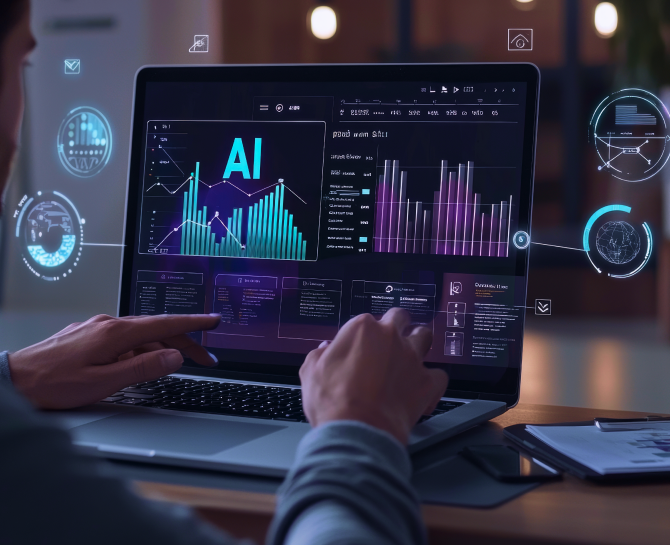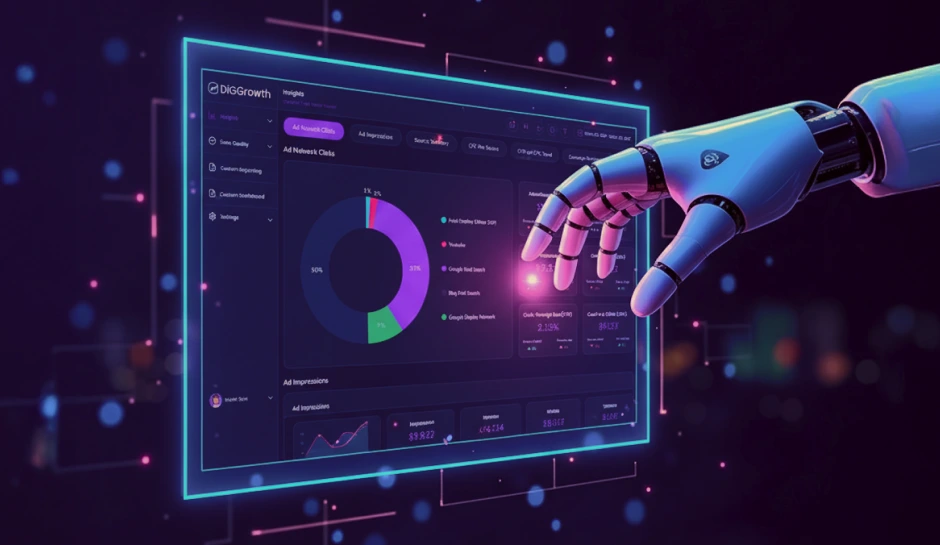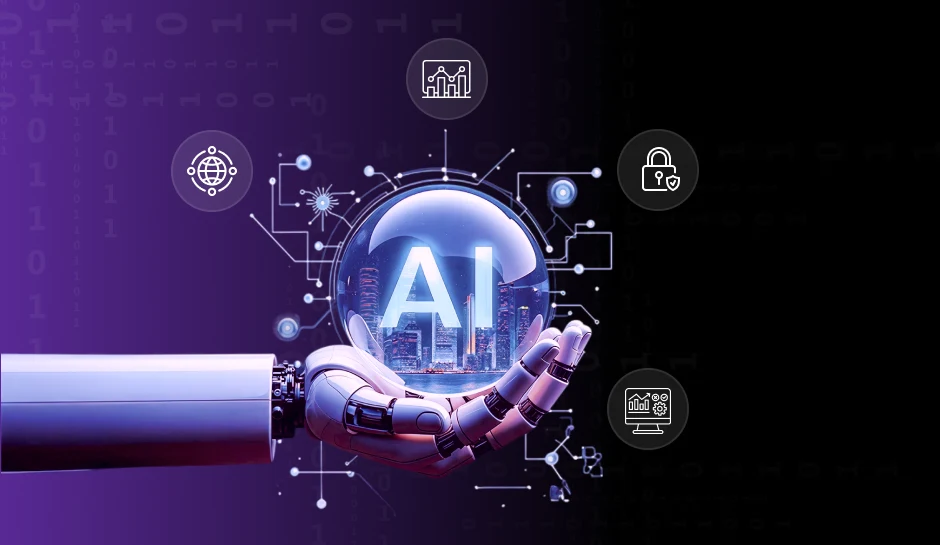
How Google Analytics Uses AI Tools to Improve Customer Insights
Google Analytics' AI-powered tools simplify complex data analysis, allowing businesses to predict customer behavior, detect trends, and optimize marketing strategies. From automated insights to audience segmentation, AI helps brands make informed decisions and improve customer engagement without manual data interpretation.
Customer behavior is more unpredictable than ever, making traditional data analysis methods insufficient for businesses that want to stay ahead. Manual reporting and surface-level metrics no longer provide the depth needed to understand evolving consumer patterns. This is where AI tools in Google Analytics are transforming the game.
Google Analytics now integrates AI-driven capabilities to process vast datasets, detect trends, and generate real-time insights. These tools help businesses predict customer actions, optimize marketing strategies, and make data-backed decisions faster than ever. From predictive analytics to automated insights, AI-powered Google Analytics tools uncover deep customer behavior patterns that were previously hidden in raw data.
But how exactly do these AI tools work, and how can businesses use them to refine customer insights? This article explores the key AI-powered features in Google Analytics and their role in optimizing data-driven decision-making.
The Role of AI in Google Analytics
Artificial intelligence is revolutionizing how businesses extract insights from Google Analytics. Instead of manually sifting through raw data, AI-powered tools automate complex analysis, revealing patterns and trends that would otherwise go unnoticed.
AI in Google Analytics enhances customer insights by:
- Processing Large Datasets Instantly:
- Uncovering Hidden Patterns:
- Predicting Customer Behavior:
- Automating Decision-Making:
AI can analyze vast amounts of user data in seconds, helping businesses identify key trends without manual effort.
AI detects correlations between user interactions, showing how different touchpoints influence conversions.
By analyzing past interactions, AI estimates future actions such as purchase likelihood or churn probability.
AI-driven insights help marketers and business owners optimize strategies without guesswork.
With AI handling real-time data interpretation, businesses can shift from reactive decision-making to proactive strategy development. The next section explores specific AI tools in Google Analytics that drive these capabilities.
AI-Driven Features That Are Changing Data Analysis
AI-powered Google Analytics tools are transforming how businesses analyze and interpret data. By automating insights, predicting customer behavior, and identifying anomalies, AI enhances decision-making and allows businesses to respond proactively to market trends. These features eliminate guesswork and provide data-driven strategies for improved performance.
Key AI Capabilities
- Predictive Metrics:
- Anomaly Detection:
- Automated Insights:
- Audience Discovery:
Forecasts customer actions such as purchase likelihood, churn probability, and conversion rates. This allows businesses to refine marketing strategies and optimize customer engagement.
Identifies unusual website traffic patterns, sales, and user engagement. Early detection helps prevent revenue losses by addressing issues before they escalate.
Generates instant reports on key trends, reducing the need for manual data analysis. Businesses receive actionable recommendations tailored to their objectives.
Segments high-value customers based on browsing behavior, past purchases, and interaction history. AI enables businesses to personalize marketing efforts for better conversions.
Pro Tip- To maximize AI-driven analytics, businesses should continuously test and refine their strategies. Regularly reviewing AI-generated insights helps companies stay ahead of market trends and optimize their campaigns for long-term success.
Key AI Tools in Google Analytics That Enhance Customer Insights
Google Analytics integrates AI-powered tools to automate data analysis, detect trends, and predict customer behavior. These tools eliminate guesswork, allowing businesses to make data-driven decisions faster. Understanding these AI capabilities helps companies optimize marketing, enhance customer engagement, and maximize return on investment.
1. Predictive Metrics: Forecasting User Behavior with AI
Google Analytics AI predicts future user actions based on past interactions. Machine learning models analyze behavioral patterns and generate insights, helping businesses anticipate customer needs. Predictive metrics reduce uncertainty in marketing decisions and allow companies to optimize advertising, customer retention, and sales strategies.
Key Predictive Metrics
- Purchase Probability:
- Churn Probability:
- Revenue Prediction:
Predicts how likely a user is to complete a transaction in the next seven days.
Identifies users at risk of disengagement, helping businesses take proactive measures.
Estimates expected revenue from specific audience segments, guiding budget allocation.
Business Applications
- E-commerce:
- Subscription-based services:
- Marketing teams:
Retarget potential buyers with personalized discounts.
Identify and engage at-risk customers before they cancel.
Adjust ad spend to target high-value audience segments.
2. Anomaly Detection: Identifying Unexpected Trends Instantly
Google Analytics AI continuously monitors website activity, detecting unusual patterns in traffic, conversions, and engagement. By flagging unexpected spikes or drops, businesses can quickly respond to potential issues, ensuring optimal performance. Anomaly detection eliminates manual data checks and provides real-time alerts for immediate action.
How It Works
- AI scans historical data to establish a normal activity baseline.
- Unusual trends are flagged, such as sudden traffic surges or conversion drops.
- Automated alerts notify businesses of significant anomalies, reducing response time.
Business Applications
- Retailers:
- SaaS companies:
- Marketing teams:
Track traffic spikes from viral content or promotions.
Monitor sudden declines in user engagement to prevent churn.
Detect advertising performance fluctuations and adjust campaigns accordingly.
3. Automated Insights: AI-Driven Reports Without Manual Effort
AI-powered automated insights in Google Analytics analyze complex datasets and generate reports without manual intervention. These insights highlight key trends, helping businesses understand customer behavior, content performance, and marketing effectiveness. Automated reporting saves time and improves decision-making efficiency.
Key Features
- Traffic Analysis:
- Engagement Insights:
- Conversion Optimization:
Identifies sources, trends, and changes in visitor behavior.
Highlights top-performing content and audience interaction trends.
Detects roadblocks affecting customer purchases or lead generation.
Business Applications
- E-commerce brands:
- Marketing teams:
- Corporate websites:
Optimize inventory and pricing based on trending products.
Adjust content strategies based on engagement reports.
Improve site navigation based on user interaction data.
4. Audience Discovery: AI-Powered Customer Segmentation
Google Analytics AI groups users into distinct segments based on demographics, behavior, and purchase intent. AI-driven audience segmentation helps businesses personalize marketing campaigns, refine targeting, and enhance user engagement. Instead of treating all users equally, businesses can focus on high-value customers and optimize marketing spend.
Key AI-Generated Audience Segments
- High-Value Customers:
- At-Risk Users:
- Lookalike Audiences:
Identifies repeat buyers and loyal users.
Segments users who have stopped engaging, helping businesses re-engage them.
Creates new audience groups that mirror high-performing customers.
Business Applications
- Advertisers:
- E-commerce businesses:
- B2B marketers:
Improve ad targeting for higher conversions.
Personalize promotions based on user interests.
Refine lead nurturing by focusing on engaged prospects.
5. Natural Language Queries: Simplifying Data Analysis
Google Analytics AI allows users to retrieve complex data insights using simple text-based queries. Instead of navigating multiple dashboards, businesses can type questions and get instant answers, making data analysis faster and more accessible.
How It Works
- “Which product category had the highest sales this quarter?”
- “What is my website’s bounce rate for the last three months?”
- AI retrieves relevant reports instantly, eliminating manual searches.
Business Applications
- Marketing teams:
- Executives:
- Product managers:
Get real-time insights without needing analytics expertise.
Make quick data-driven decisions by asking direct questions.
Track user trends efficiently without complex reporting.
How These AI Tools Improve Customer Insights
Google Analytics AI tools transform raw data into meaningful insights, allowing businesses to make data-driven decisions with confidence. By leveraging AI-powered analytics, companies can better understand customer behavior, refine marketing strategies, and improve overall business performance. Here is how these AI tools enhance customer insights:
1. Understanding Customer Behavior: Identifying Trends in Website Interactions
AI in Google Analytics tracks user interactions, helping businesses understand how visitors engage with their website. AI detects trends that reveal user intent and preferences by analyzing navigation patterns, session duration, and click-through rates.
Key AI Capabilities
- Behavior Flow Analysis:
- Session Duration & Engagement Scores:
- Bounce Rate Insights:
Tracks user journeys to identify common navigation paths.
Evaluates content effectiveness and user interest.
Pinpoints pages where users leave without interacting further.
Business Applications
- E-commerce websites:
- Media platforms:
- Service-based businesses:
Optimize product pages based on engagement trends.
Enhance content strategies by analyzing reading patterns.
Improve website usability for better lead generation.
2. Improving Audience Targeting: Refining Ad Campaigns Based on Predictive Insights
Google Analytics AI segments users based on behavior, demographics, and purchase intent. This allows businesses to create hyper-targeted marketing campaigns that reach the right audience at the right time.
Key AI Capabilities
- Lookalike Audiences:
- Predictive Targeting:
- Real-Time Personalization:
Identifies new users similar to existing high-value customers.
Suggests ideal audience segments for ads
Customizes content and offers based on user behavior.
Business Applications
- Retail brands:
- B2B marketers:
- Ad agencies:
Deliver personalized promotions to users likely to convert.
Optimize lead nurturing by focusing on engaged prospects.
Reduce ad spend waste by targeting high-intent users.
3. Optimizing Conversion Strategies: Detecting Bottlenecks in the Customer Journey
AI helps identify barriers that prevent users from completing purchases or taking desired actions. By analyzing drop-off points in the conversion funnel, businesses can make data-backed improvements to boost conversions.
Key AI Capabilities
- Cart Abandonment Analysis:
- Landing Page Performance:
- A/B Testing Optimization:
Detects why users leave before completing a purchase.
Evaluates content effectiveness and user engagement.
Recommends design and copy changes to maximize conversions.
Business Applications
- E-commerce stores:
- Subscription services:
- Lead generation businesses:
Reduce checkout abandonment by optimizing payment flows.
Identify friction points in sign-up processes.
Improve form design to increase conversions.
4. Reducing Data Overload: Simplifying Complex Datasets for Actionable Insights
AI automates data processing, filtering noise and delivering only the most relevant insights. This eliminates manual data interpretation and allows businesses to focus on strategic actions.
Key AI Capabilities
- Automated Insights:
- Natural Language Queries:
- Smart Summaries:
Highlights significant trends without manual analysis.
Enables users to ask simple questions and get direct answers.
Generates easy-to-understand reports with key takeaways.
Business Applications
- Marketing teams:
- Executives:
- Product managers:
Save time by instantly accessing actionable insights.
Make informed decisions without technical expertise.
Track feature performance without data overload.
Key Takeaways
- AI tools in Google Analytics automate data analysis, reducing the time needed for businesses to uncover actionable insights.
- Predictive analytics improve customer targeting by forecasting behaviors like purchase probability and churn risk.
- Anomaly detection helps businesses react to unusual trends before they impact revenue.
- Automated insights eliminate guesswork, providing real-time reports tailored to business needs.
- AI-driven audience segmentation allows businesses to personalize marketing efforts and maximize return on investment.
Conclusion
AI in Google Analytics is not just about automation—it is about making smarter, data-driven decisions that shape the future of business strategy. Traditional analytics rely on past data, but AI empowers businesses to predict customer behavior, identify opportunities, and respond proactively to market trends. This shift from reactive to proactive decision-making helps companies stay ahead in an increasingly competitive digital landscape.
Ignoring AI-driven insights means leaving growth opportunities untapped. Businesses that leverage these tools will refine their marketing strategies, optimize user experiences, and maximize returns with precision. The future of data analysis is not about working harder—it is about working smarter with AI-powered insights that drive meaningful results.
Wish to Unlock Success With a Google Analytics AI?
Just write to us at info@diggrowth.com to explore how AI-driven insights can enhance your marketing and business performance.
Ready to get started?
Increase your marketing ROI by 30% with custom dashboards & reports that present a clear picture of marketing effectiveness
Start Free Trial
Experience Premium Marketing Analytics At Budget-Friendly Pricing.

Learn how you can accurately measure return on marketing investment.
Additional Resources
How Predictive AI Will Transform Paid Media Strategy in 2026
Paid media isn’t a channel game anymore, it’s...
Read full post postDon’t Let AI Break Your Brand: What Every CMO Should Know
AI isn’t just another marketing tool. It’s changing...
Read full post postFrom Demos to Deployment: Why MCP Is the Foundation of Agentic AI
A quiet revolution is unfolding in AI. And...
Read full post postFAQ's
AI identifies keyword trends, analyzes search intent, and provides insights on content performance. It helps businesses optimize their website structure, improve user engagement, and enhance ranking strategies based on predictive search behavior.
Yes, AI-powered anomaly detection flags suspicious traffic patterns, such as bot activity or fake clicks. It helps businesses identify invalid traffic sources and protect advertising budgets from fraud.
Absolutely. AI automates data analysis, helping small businesses gain valuable insights without needing a dedicated analytics team. It improves targeting, enhances marketing efficiency, and simplifies decision-making for businesses with limited resources.
AI evaluates how different touchpoints contribute to conversions, providing a clearer picture of the customer journey. It helps businesses allocate marketing budgets effectively by identifying high-impact channels.
Yes, businesses can set specific objectives, and AI tailors insights based on those goals. Whether optimizing for conversions, engagement, or customer retention, AI delivers relevant recommendations aligned with business needs.


